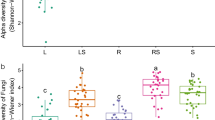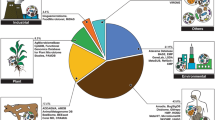Abstract
Microorganisms are ubiquitous in the atmosphere with hundreds of taxa being identified in air samples collected around the world. Despite their importance on human and ecosystem health, the majority of air microbiological studies have been limited to cultivation-based methods that may not capture all of the microbial diversity in the air. The present study used pyrosequencing analysis of 16S rDNA fragments, in order to examine the short-term variability of microbial assemblage composition in near-surface atmosphere of two coastal cities of Crete island, eastern Mediterranean Sea. A diverse range of 16S rRNA genes was identified at both cities consisting of 17,720 different operation taxonomic units, 23 bacterial and 3 archaeal phyla, 93 orders and 204 families. A core microbiome containing members of Proteobacteria, Actinobacteria and Firmicutes was evidenced at both study sites, regardless the origin of transported air masses. Nevertheless, the local biodiversity profiles presented extensive differences at lower taxonomic level (i.e., species). A total of 7699 sequences were closely related to 101 strains that are commonly found in many different habitats, including agricultural soil, water, air, marine water and sediment, as well as human microbiome. Several of these strains were closely related to pathogens or putative pathogens, which can trigger infections, such as bacteremia and endocarditis to humans and blackleg disease in plants. The identified large differences in local biodiversity together with the presence of many pathogenic relatives demonstrate the significance of spatial variability in atmospheric biogeography and the importance to include airborne microbes in air quality studies.



Similar content being viewed by others
References
Bowers, R. M., Clements, N., Emerson, J. B., Wiedinmyer, C., Hannigan, M. P., & Fierer, N. (2013). Seasonal variability in bacterial and fungal diversity of the near- surface atmosphere. Environmental Science and Technology, 47, 12097–12106.
Bowers, R. M., Lauber, C. L., Wiedinmyer, C., Hamady, M., Hallar, A. G., Fall, R., et al. (2009). Characterization of airborne microbial communities at a high-elevation site and their potential to act as atmospheric ice nuclei. Applied and Environmental Microbiology, 75, 5121–5130.
Bowers, R. M., McLetchie, S., Knight, R., & Fierer, N. (2011a). Spatial variability in airborne bacterial communities across land-use types and their relationship to the bacterial communities of potential source environments. The ISME Journal, 5, 601–612.
Bowers, R. M., Sullivan, A. P., Costello, E. K., Collett, J. L., Jr., Knight, R., & Fierer, N. (2011b). Sources of bacteria in outdoor air across cities in the Midwestern United States. Applied and Environmental Microbiology, 77, 6350–6356.
Burrows, S. M., Elbert, W., Lawrence, M. G., & Pöschl, U. (2009). Bacteria in the global atmosphere—Part 1: Review and synthesis of literature data for different ecosystems. Atmospheric Chemistry and Physics, 9, 9263–9280.
Cao, C., Jiang, W., Wang, B., Fang, J., Lang, J., Tian, G., et al. (2014). Inhalable microorganisms in Beijing’s PM2.5 and PM10 pollutants during a severe smog event. Environmental Science and Technology, 48, 1499–1507.
Caporaso, J. G., Kuczynski, J., Stombaugh, J., Bittinger, K., Bushman, F. D., Costello, E. K., et al. (2010). QIIME allows analysis of high-throughput community sequencing data. Nature Methods, 7, 335–336. https://doi.org/10.1038/nmeth.f.303.
Cho, B. C., & Hwang, C. Y. (2011). Prokaryotic abundance and 16S rRNA gene sequences detected in marine aerosols on the East Sea (Korea). FEMS Microbiology Ecology, 76, 327–341.
Cole, J. R., Wang, Q., Fish, J. A., Chai, B., McGarrell, D. M., Sun, Y., et al. (2014). Ribosomal database project: Data and tools for high throughput rRNA analysis. Nucleic Acids Research, 42, D633–D642.
Colwell, R. K., & Coddington, J. A. (1994). Estimating terrestrial biodiversity through extrapolation. Philosophical Transactions of the Royal Society B Biological Sciences, 345(1311), 101–118.
DeLeon-Rodriguez, N., Lathem, T. L., Rodriguez-R, L. M., Barazesh, J. M., Anderson, B. E., Beyersdorf, A. J., et al. (2014). Microbiome of the upper troposphere: Species composition and prevalence, effects of tropical storms, and atmospheric implications. Proceedings of the National Academy of Sciences USA, 110, 2575–2580.
DeSantis, T. Z., Hugenholtz, P., Larsen, N., Rojas, M., Brodie, E. L., Keller, K., et al. (2006). Greengenes, a chimera-checked 16S rRNA gene database and workbench compatible with ARB. Applied and Environmental Microbiology, 72(7), 5069–5072.
Despres, V. R., Nowoisky, J. F., Klose, M., Conrad, R., Andreae, M. O., & Poschl, U. (2007a). Characterization of primary biogenic aerosol particles in urban, rural, and high-alpine air by DNA sequence and restriction fragment analysis of ribosomal RNA genes. Biogeosciences, 4, 1127–1141.
Despres, V., Nowoisky, J., Klose, M., Conrad, R., Andreae, M. O., & Poschl, U. (2007b). Molecular genetics and diversity of primary biogenic aerosol particles in urban, rural, and high-alpine air. Biogeosciences Discussion, 4, 349–384.
Draxler, R. R., & Rolph, G. D. (2003). HYSPLIT (hybrid single-particle lagrangian integrated trajectory). Available http://www.arl.noaa.gov/ready/hysplit4.html.
Fey, P. D., & Olson, M. E. (2010). Current concepts in biofilm formation of Staphylococcus epidermidis. Future Microbiology, 5(6), 917–933.
Fierer, N., Hamady, M., Lauber, C. L., & Knight, R. (2008a). The influence of sex, handedness, and washing on the diversity of hand surface bacteria. Proceedings of the National Academy of Sciences USA, 105, 17994–17999.
Fierer, N., Liu, Z., Rodriguez-Hernandez, M., Knight, R., Henn, M., & Hernandez, M. T. (2008b). Short-term temporal variability in airborne bacterial and fungal populations. Applied and Environmental Microbiology, 74, 200–207.
Greenblatt, C., Baum, J., Klein, B. Y., Nachshon, S., Koltunov, V., & Cano, R. J. (2004). Micrococcus luteus—survival in amber. Microbial Ecology, 48, 120–127.
Griffin, D. W. (2007). Atmospheric movement of microorganisms in clouds of desert dust and implications for human health. Clinical Microbiology Reviews, 20, 459–477.
Griffin, D. W., & Kellogg, C. A. (2004). Dust storms and their impact on ocean and human health: Dust in Earth’s atmosphere. EcoHealth, 1, 284–295.
Griffin, D. W., Kubilay, N., Kocak, M., Gray, M. A., Borden, T. C., & Shinn, E. A. (2007). Airborne desert dust and aeromicrobiology over the Turkish Mediterranean coastline. Atmospheric Environment, 41, 4050–4062.
Gromkova, R. C., Mottalini, T. C., & Dove, M. G. (1998). Genetic transformation in Haemophilus parainfluenzae clinical isolates. Current Microbiology, 37(2), 123–126.
Grünwald, N. J., Garbelotto, M., Goss, E. M., Heungens, K., & Prospero, S. (2012). Emergence of the sudden oak death pathogen Phytophthora ramorum. Trends in Microbiology, 20(3), 131–138.
Hayashi, H., Shibata, K., Sakamoto, M., Tomita, S., & Benno, Y. (2007). Prevotella copri sp. nov. and Prevotella stercorea sp. nov., isolated from human faeces. International Journal of Systematic and Evolutionary Microbiology, 57, 941–946.
Hirano, S. S., & Upper, C. D. (2000). Bacteria in the leaf ecosystem with emphasis on Pseudomonas syringae - a pathogen, ice nucleus, and epiphyte. Microbiology and Molecular Biology Reviews, 64, 624–653.
Jaenicke, R. (2005). Abundance of cellular material and proteins in the atmosphere. Science, 308, 73.
Jeon, E. M., Kim, H. J., Jung, K., Kim, J. H., Kim, M. Y., Kim, Y. P., et al. (2011). Impact of Asian dust events on airborne bacterial community assessed by molecular analyses. Atmospheric Environment, 45, 4313–4321.
Kageyama, A., Benno, Y., & Nakase, T. (1999). Phylogenetic and phenotypic evidence for the transfer of Eubacterium aerofaciens to the genus Collinsella as Collinsella aerofaciens gen. nov., comb. nov. International Journal of Systematic Bacteriology, 49, 557–565.
Katra, I., Arotsker, L., Krasnov, H., Zaritsky, A., Kushmaro, A., & Ben-Dov, E. (2014). Richness and diversity in dust stormborne biomes at the Southeast Mediterranean. Scientific Reports, 4, 5262. https://doi.org/10.1038/srep05265.
Kirschbaum, J. O., & Kligman, A. M. (1963). The pathogenic role of Corynebacterium acnes in acne vulgaris. Archives of Dermatology, 88, 832–833.
Ku, S. C., Hsueh, P. R., Yang, P. C., & Luh, K. T. (2000). Clinical and microbiological characteristics of bacteremia caused by Acinetobacter lwoffii. European Journal of Clinical Microbiology and Infectious Diseases, 19(7), 501–505.
Lighthart, B. (2000). Mini-review of the concentration variations found in 619 the alfresco atmospheric bacterial populations. Aerobiologia, 16, 7–16.
Lighthart, B., & Shaffer, B. T. (1995a). Viable bacterial aerosol particle size distributions in the midsummer atmosphere at an isolated location in the high desert chaparral. Aerobiologia, 11, 19–25.
Lighthart, B., & Shaffer, B. T. (1995b). Airborne bacteria in the atmosphere surface layer: Temporal distribution above a grass seed field. Applied and Environmental Microbiology, 61, 1492–1496.
Martín, R., Miquel, S., Benevides, L., Bridonneau, C., Robert, V., Hudault, S., et al. (2017). Functional characterization of novel Faecalibacterium prausnitzii strains isolated from healthy volunteers: A step forward in the use of F. prausnitzii as a next-generation probiotic. Frontiers in Microbiology, 8, 1226.
Mayol, E., Arrieta, J. M., Jiménez, M. A., Martínez-Asensio, A., Garcias-Bonet, N., Dachs, J., et al. (2017). Long-range transport of airborne microbes over the global tropical and subtropical ocean. Nature Communications, 8, 201. https://doi.org/10.1038/s41467-017-00110-9.
McCartney, H. A., Fitt, B. D. L., & Schmechel, D. (1997). Sampling bioaerosols in plant pathology. Journal of Aerosol Science, 28, 349–364.
Nørskov-Lauritsen, N. (2014). Classification, identification, and clinical significance of Haemophilus and Aggregatibacter species with host specificity for humans. Clinical Microbiology Reviews, 27(2), 214–240.
Oyaert, M., De Baere, T., Breyne, J., De Laere, E., Mariën, S., Waets, P., et al. (2013). First case of Pseudoclavibacter bifida bacteremia in an immunocompromised host with chronic obstructive pulmonary disease (COPD). Journal of Clinical Microbiology, 51(6), 1973–1976.
Polymenakou, P. N. (2012). Atmosphere: A source of pathogenic or beneficial microbes? Atmosphere, 3, 87–102.
Polymenakou, P. N., Christakis, C. A., Mandalakis, M., & Oulas, A. (2015). Pyrosequencing analysis of microbial communities reveals dominant cosmopolitan phylotypes in deep-sea sediments of the eastern Mediterranean Sea. Research in Microbiology, 166, 448–457.
Polymenakou, P. N., & Mandalakis, M. (2013). Assessing the short-term variability of bacterial composition in background aerosols of the Eastern Mediterranean during a rapid change of meteorological conditions. Aerobiologia, 29, 429–441.
Polymenakou, P. N., Mandalakis, M., Stephanou, E. G., & Tselepides, A. (2008). Particle size distribution of airborne microorganisms and pathogens during an intense African dust event in the Eastern Mediterranean. Environmental Health Perspectives, 116, 292–296.
Quast, C., Pruesse, E., Yilmaz, P., Gerken, J., Schweer, T., Yarza, P., et al. (2013). The SILVA ribosomal RNA gene database project: Improved data processing and web-based tools. Nucleic Acids Research, 41, D590–D596.
Quince, C., Lanzen, A., Davenport, R. J., & Turnbaugh, P. J. (2011). Removing noise from pyrosequenced amplicons. BMC Bioinformatics, 12, 38.
Radosevich, J. L., Wilson, W. J., Shinn, J. H., DeSantis, T. Z., & Andersen, G. L. (2002). Development of a high-volume aerosol collection system for the identification of air-borne micro-organisms. Letters in Applied Microbiology, 34, 162–167.
Ricaurte, J. C., Klein, O., Labombardi, V., Martinez, V., Serpe, A., & Joy, M. (2001). Rothia dentocariosa endocarditis complicated by multiple intracranial hemorrhages. Southern Medical Journal, 94(4), 438–440.
Rosenberg, E., Koren, O., Reshef, L., Efrony, R., & Zilber-Rosenberg, I. (2007). The role of microorganisms in coral health, disease and evolution. Nature Reviews Microbiology, 5, 355–362.
Rosselli, R., Fiamma, M., Deligios, M., Pintus, G., Pellizzaro, G., Canu, A., et al. (2015). Microbial immigration across the Mediterranean via airborne dust. Scientific Reports, 5, 16306. https://doi.org/10.10385/srep16306.
Smets, W., Moretti, S., Denys, S., & Lebeer, S. (2016). Airborne bacteria in the atmosphere: Presence, purpose, and potential. Atmospheric Environment, 139, 214–221.
Swanson, C. A., & Sliwinski, M. K. (2013). Archaeal assemblages inhabiting temperate mixed forest soil fluctuate in taxon composition and spatial distribution over time. Archaea, article ID: 870825.
Tong, S. Y., Davis, J. S., Eichenberger, E., Holland, T. L., & Fowler, V. G. (2015). Staphylococcus aureus infections: Epidemiology, pathophysiology, clinical manifestations, and management. Clinical Microbiology Reviews, 28(3), 603–661.
Wiedinmyer, C., Bowers, R. M., Fierer, N., Horanyi, E., Hannigan, M., Gannet Hallar, A., et al. (2009). The contribution of biological particles to observed particulate organic carbon at a remote high altitude site. Atmospheric Environment, 43, 4278–4282.
Acknowledgements
This work was supported by the Hellenic Centre for Marine Research and the Institute of Marine Biology, Biotechnology and Aquaculture through the General Secretariat for Research and Technology, Hellenic Ministry of Education, Research and Religious Affairs.
Author information
Authors and Affiliations
Corresponding author
Electronic supplementary material
Below is the link to the electronic supplementary material.
Rights and permissions
About this article
Cite this article
Polymenakou, P.N., Mandalakis, M., Macheras, M. et al. High genetic diversity and variability of microbial communities in near-surface atmosphere of Crete island, Greece. Aerobiologia 36, 341–353 (2020). https://doi.org/10.1007/s10453-020-09636-w
Received:
Accepted:
Published:
Issue Date:
DOI: https://doi.org/10.1007/s10453-020-09636-w




